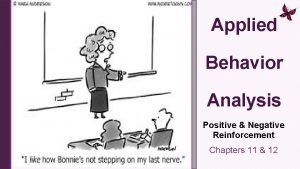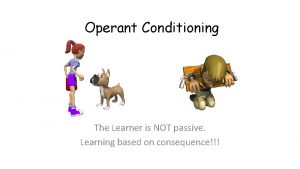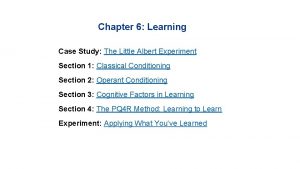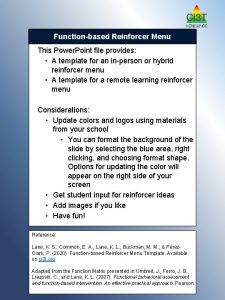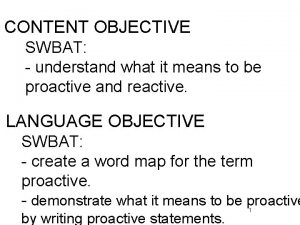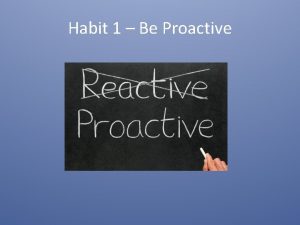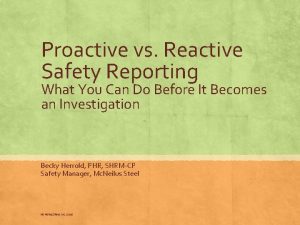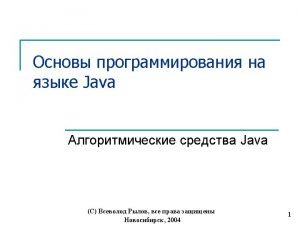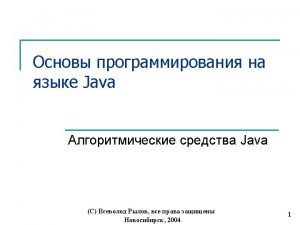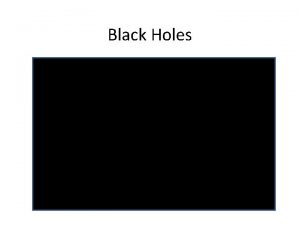Task as Reinforcer A Reactive Alternative to Escape






















- Slides: 22

Task as Reinforcer: A Reactive Alternative to Escape Extinction Steve Ward, MA, BCBA Whole Child Consulting, LLC www. wholechildconsulting. com http: //www. facebook. com/wholechildc onsulting

Escape behavior is a problem • Escape/avoidance is the most common function of SIB (38. 1%) (Iwata, et al, 1994) • Students of all types postpone work, and some have devised elaborate or intense escape/avoidance routines • For students learning in a group format, the more they avoid, the further behind they become, the more they need to avoid

Some Proactive measures Condition tasks as reinforcers Frequent reinforcement Demand fading Errorless teaching (*sometimes the opposite of helpful) • Curricular revision • Visual schedules • •

Usually more effective when combined with escape extinction • Escape extinction has been used effectively as a treatment component (e. g. , combined with demand fading) (Mason & Iwata, 1990; Pace, Iwata, Cowdery, Andree, & Mc. Intyre, 1993; Steege, Wacker, Berg, Cigrand, & Cooper, 1989) • This is usually* true, except when escape extinction causes more problems than it solves (e. g. , Selina)

Escape extinction can have negative side effects • Aggression, increased frequency and intensity of target behavior (Goh & Iwata, 1994; Lerman, Iwata, & Wallace, 1999) • Condition teacher and/or activities as aversives

What EXACTLY does escape extinction look like? • “Sit there until you’re finished” • Nag (repeated verbal SD’s) • Hand-over-hand • How long, how often, contingent upon what behaviors, how much feedback? • There are several variable dimensions in need of exploration

You’ll remember, of course, what Jack Michael (1993) said about reinforcement as a “dynamic process” • Neither reinforcement nor punishment are “static”. We have to consider the postbehavior context relative to the pre-behavior context.

This suggests at least 2 broad options • Make the “post” that much better or make the “pre” that much worse. When things are going pretty well, we focus primarily upon making the world better after cooperation. When the student is non-cooperative, we shouldn’t look for ways to make the world better if he will cooperate or remind him what he “is working for”, but we need to consider what things are contingent upon cooperation.

Pre-cooperation conditions: Continuum of intrusion Most intrusive Least intrusive Hand-overhand escape extinction Contained within work room, verbal and gestural reminders, but no HOH Contained within work area. No reminders* to cooperate. Allowed to leave work area, no reminders to return to work. 1 -3 potential reinforcers withheld. Positive attention provided to cooperative peers (contingent attention) (e. g. , Iwata, Pace, Kalsher, Cowdery & Cataldo, 1990) Piazza, Moes, and Fisher (1996) Current study. Ward, Parker, Grimes, & Perdikaris, (201 6? ) (e. g. , “Baby Bunny Ribbon Time out”, The Tough Kid Handbook and Schramm’s “ 7 steps”) (e. g. , Madsen, Becker, & Thomas, 1968)

Advantages of wait outs? • Wait outs can usually be implemented without physical contact, decreasing the possibility of aggression • It can be difficult to clearly distinguish pure escape/avoidance from behavior also maintained by attention. “Wait outs” make attention* contingent upon readiness. • For those who don’t like attention, the procedure can help to condition attention as a reinforcer, removed from the “nag” context and put into the “moving forward” context.

Work materials available Works well Doesn’t work well (active or passive) Confirms readiness Not ready “That’s not ready” and remove materials* and limit access to rfs. “Ready? ”, while offering work materials Calms/focuse s for at least 5 seconds

So, we’re following inappropriate escape behaviors with escape?

It works • Study 1 -3 students new to a special needs clinic. Wait outs are the only reactive measure. • Study 2 -multiple baseline across stressors • Study 3 -wait outs used to treat “passive resistance” for 2 activities with 1 student, in a multiple baseline.

Gathering data (these are actual data from one student) Date Total Duration # of daily episodes 1/14 0: 00: 15 3 1/14 0: 00: 40 1/14 0: 02 1/15 Number of rejections 3 1/15 1/16 0: 03: 17 0: 00: 29 1 0: 12: 45 1/16 0: 05: 36 1/20 0: 05 1/20 0: 01: 00 1/20 0: 01: 23 1/21 2 3 0: 01: 59 1 1/22 NA 0 1/27 0: 05 1 1/28 NA 0

Days 3/ 2/ 15 15 15 2/ 2/ 1/ 15 5 /1 31 / 2/ 1/ 5 /1 30 1/ 5 /1 29 1/ 5 /1 28 1/ 5 /1 27 1/ 5 /1 26 1/ 5 /1 25 1/ 5 /1 24 1/ 5 /1 23 1/ 5 /1 22 1/ 5 /1 21 1/ 20 1/ 5 /1 19 1/ 5 /1 18 1/ 5 /1 17 1/ 5 /1 16 1/ 5 /1 15 1/ 14 1/ Count and duration Those data are graphed for Drew 20 18 16 14 12 10 Frequency 8 Duration 6 4 2 0

Days 5/12/15 5/11/15 5/10/15 5/9/15 5/8/15 5/7/15 5/6/15 5/5/15 5/4/15 5/3/15 5/2/15 5/1/15 4/30/15 4/29/15 4/28/15 4/27/15 4/26/15 4/25/15 4/24/15 4/23/15 4/22/15 4/21/15 4/20/15 4/19/15 4/18/15 4/17/15 4/16/15 4/15/15 4/14/15 4/13/15 Count and minutes And for Jack 45 40 35 30 25 20 frequency duration 15 10 5 0

Days 5 5 /1 27 4/ /1 26 15 25 / 4/ 4/ 5 5 /1 24 4/ 5 /1 23 4/ /1 22 4/ 5 5 /1 21 4/ /1 20 4/ 5 5 /1 19 4/ 5 /1 18 4/ /1 17 4/ 5 5 /1 16 4/ 5 /1 15 4/ /1 14 4/ 5 /1 13 4/ Count and minutes And for Adi 4. 5 4 3. 5 3 2. 5 2 frequency duration 1. 5 1 0. 5 0

Appropriate tolerance 100% 90% 80% 70% 60% 50% 40% 30% 20% 10% 0% BL Wait outs 1 2 3 4 5 6 7 8 9 10 11 12 13 14 15 8 9 10 11 100% 90% 80% 70% 60% 50% 40% 30% 20% 10% 0% 1 2 3 4 5 6 7 sessions 12 13 14 15

Study 3 -treating passive resistance 100% • Baseline RD People WO for missing transfers 90%. 80% 70% 60% 50% 40% 30% 20% 10% 0% 1 2 1 3 4 5 6 7 8 9 10 12 13 14 15 16 17 WO for missing transfers Baseline RD Colors 0. 9 11 0. 8 0. 7 0. 6 0. 5 0. 4 0. 3 0. 2 0. 1 0 1 2 3 4 5 6 7 8 9 sessions 10 11 12 13 14

Potential benefits in comparison to escape extinction • Less confrontational • CMO-R becomes conditioned rf (opportunity to move forward). *This is a step towards selfmanagement and the efficacy of delayed consequences. • Especially for less-disruptive students, wait outs are much more practical than escape extinction in classroom environments • Social validity

Common errors • Failing to use positioning to clarify communication • Representing work without asking whether “ready? ” (same as “nag” procedure) • **Remember that waiting only works if the “pre” is less valuable than the “post” Swimming Doesn’t get out for work Wait out with him in pool?

Limitations • The more a student is truly into selfstimulatory behavior, the harder “wait outs” are to use effectively (requires frequent blocking of self-stimulatory behavior)
 Stimulus control aba example
Stimulus control aba example Tertiary reinforcer
Tertiary reinforcer Intermittent schedule of reinforcement
Intermittent schedule of reinforcement Habituation ap psychology
Habituation ap psychology Example of fixed ratio schedule
Example of fixed ratio schedule Discriminative stimulus psychology definition
Discriminative stimulus psychology definition What is a secondary reinforcer
What is a secondary reinforcer Shaping in operant conditioning
Shaping in operant conditioning Reinforcer menu
Reinforcer menu Fixed interval positive reinforcement
Fixed interval positive reinforcement Tiered task bias task
Tiered task bias task Reactivity of periodic table
Reactivity of periodic table What does swbat mean
What does swbat mean Proactive vs reactive 7 habits
Proactive vs reactive 7 habits Motor system components
Motor system components Proactive vs reactive 7 habits
Proactive vs reactive 7 habits Draw the power triangle
Draw the power triangle Fatal if swallowed pictogram
Fatal if swallowed pictogram Reactive anger
Reactive anger Proactive vs reactive safety
Proactive vs reactive safety Reactive mpr
Reactive mpr Reactive arthritis pathophysiology
Reactive arthritis pathophysiology Nucleophilic substitution of carboxylic acids
Nucleophilic substitution of carboxylic acids
